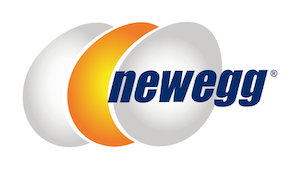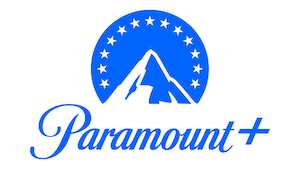For Part 2 of our coverage of the Star Wars: Shatterpoint — Requesting Your Surrender Squad Pack, I will be going through the step-by-step process to get them out of gray and ready for play. These tutorials are meant to get your miniatures painted and make them stand out on the table.
If you would like to see the unboxing and review, check out our Part 1 article here where I go more into prepping these pieces for priming and painting.
PAINT LIST
I use a wide variety of paint lines, but the majority of what I use for painting is Games Workshop’s Citadel Paints, Army Painter, and Pro Acryl. I also make sure to mix in Liquitex Flow-Aid Additive to the paint pots and dropper bottles so that the paints are a little thinner and ready to add right onto my wet-pallet. For this tutorial, I have included a list of all the paints and primers I used so you have an easily-accessible list to refer to if you need to go shopping. The paints are noted on the pictures of each character and in the optional ‘Basing’ section. Many paints are used for multiple figures, so a single bottle will be more than enough.
- Primers
- Rusteolum Flat Black Primer
- Rusteolum Flat Gray Primer
- Army Painter Matte White Colour Primer -OR- Citadel White Scar Primer
NOTE: You don’t need to use these exact paints, and can substitute with the paints and colors you have from other paint lines. Most of these colors are fairly generic, and I use them for multiple projects. I only recommend going out and buying a new paint or color if you think you’re going to use it for multiple projects in the future.
PRIMING

In general terms, getting the majority of a color for a model applied via a rattle can or airbrush saves a lot of time. I chose to paint the figures separate from the bases so I could paint the bases faster and keep the colors as neatly as possible. I used some old bases and affixed the figures to those bases with some Gorilla Glue Tough & Clear Mounting Tape. The tape keeps the figures held in place very well and they are easy to remove once I am done painting.
Kit Fisto and Nahdar Vebb I did with a zenithal prime on them, with a base coat of Rustoleum Flat Black and a top coat of Army Painter White Primer. The Clones also receive the zenithal prime treatment, but I used a base coat of Rustoleum Flat Gray Primer instead. More on this later.
MODEL PAINTING
For pretty much every miniature paint project I do, I start with a plan. In advance of putting the brush to model, I find photo references of the paint schemes and details I am looking for. Most times this means having a browser window up with different web pages and images next to my painting area, so I can quickly refer to them as I paint. I also come up with a paint plan, choosing what colors I am going to use and what order I apply them in.
I typically start with ‘color blocking;’ a technique where I apply the mid-range of the color I want to use through contrast/speed-paints, washes, and sometimes base paints. As I usually do a black and white zenithal prime, the contrast/speed paints provide a blend of color over the top of the priming, giving me a nice gradient with which to work with later for shading and highlighting (if I choose to do detailing). I do all of my color blocking first before going back in and doing the detailing. I start with the lightest tones first and then work down the range to the darkest tones. Lastly, I do the work for the bases, whether the figures are on them or separately.
Quick Paint & Detailing
In the photos below, I have included a list of the paints I’ve used for each model. The colors above the white line are meant to be the ‘Quick Paint’ colors. These are the paints that give a main, basic color to each part of the miniature (skin, clothes, gear, etc.). With zenithal priming and contrast/quick/speed paints, your model will be 80% of the way there in terms of tone, shading, and highlighting. For most tournaments, ‘battle ready’ or ‘tournament legal’ painting requires at least three colors: if you follow these guides you’ll be set. However, if you’re wanting to push your painting a little further and give these characters a little more detail, you can continue down the list of paints to add more highlights. This guide is meant to help you build confidence with miniature painting. We’re not going for gold medals on these models - this is simply a guide to get your pieces painted. Remember that done is better than perfect!
Let’s get painting!
Kit Fisto
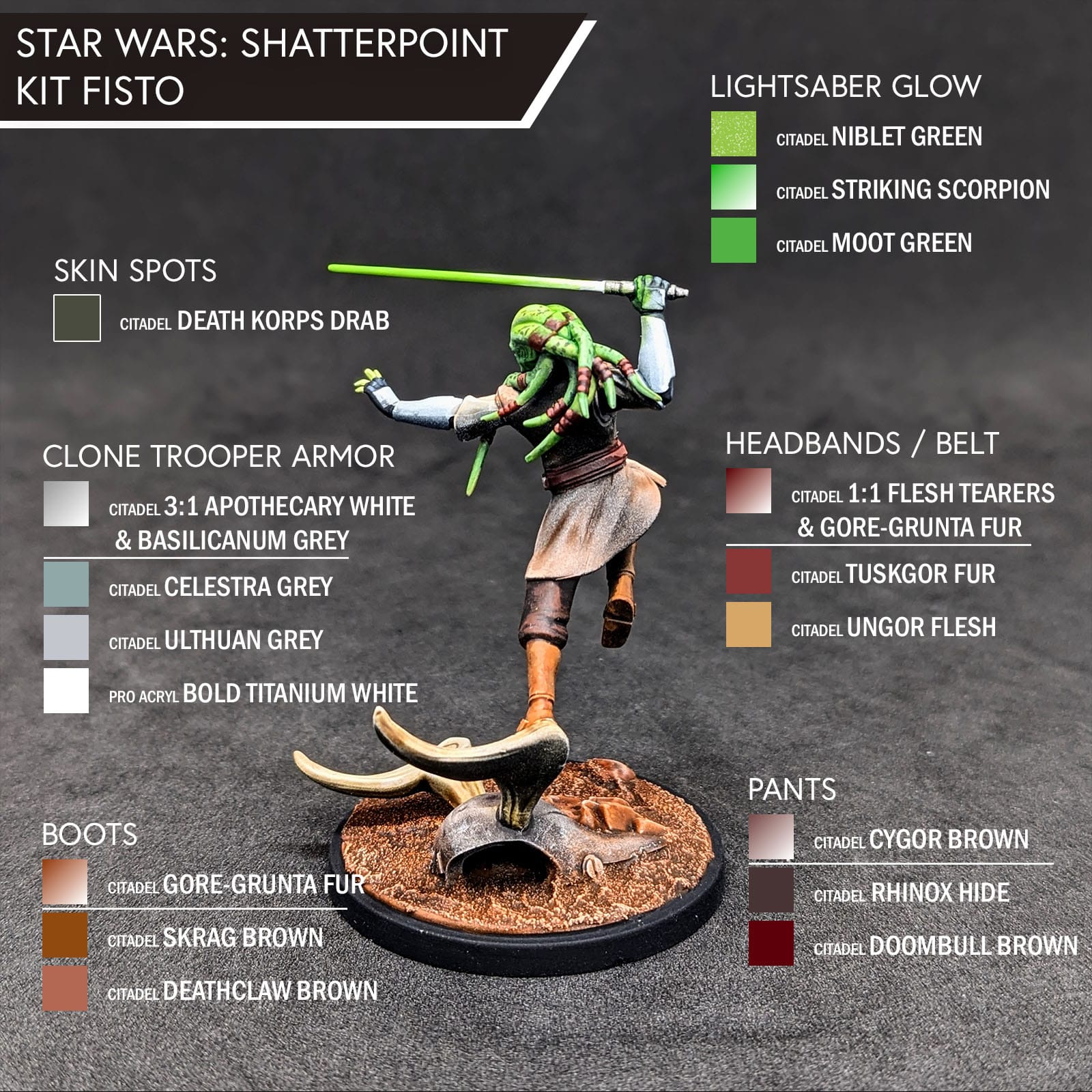
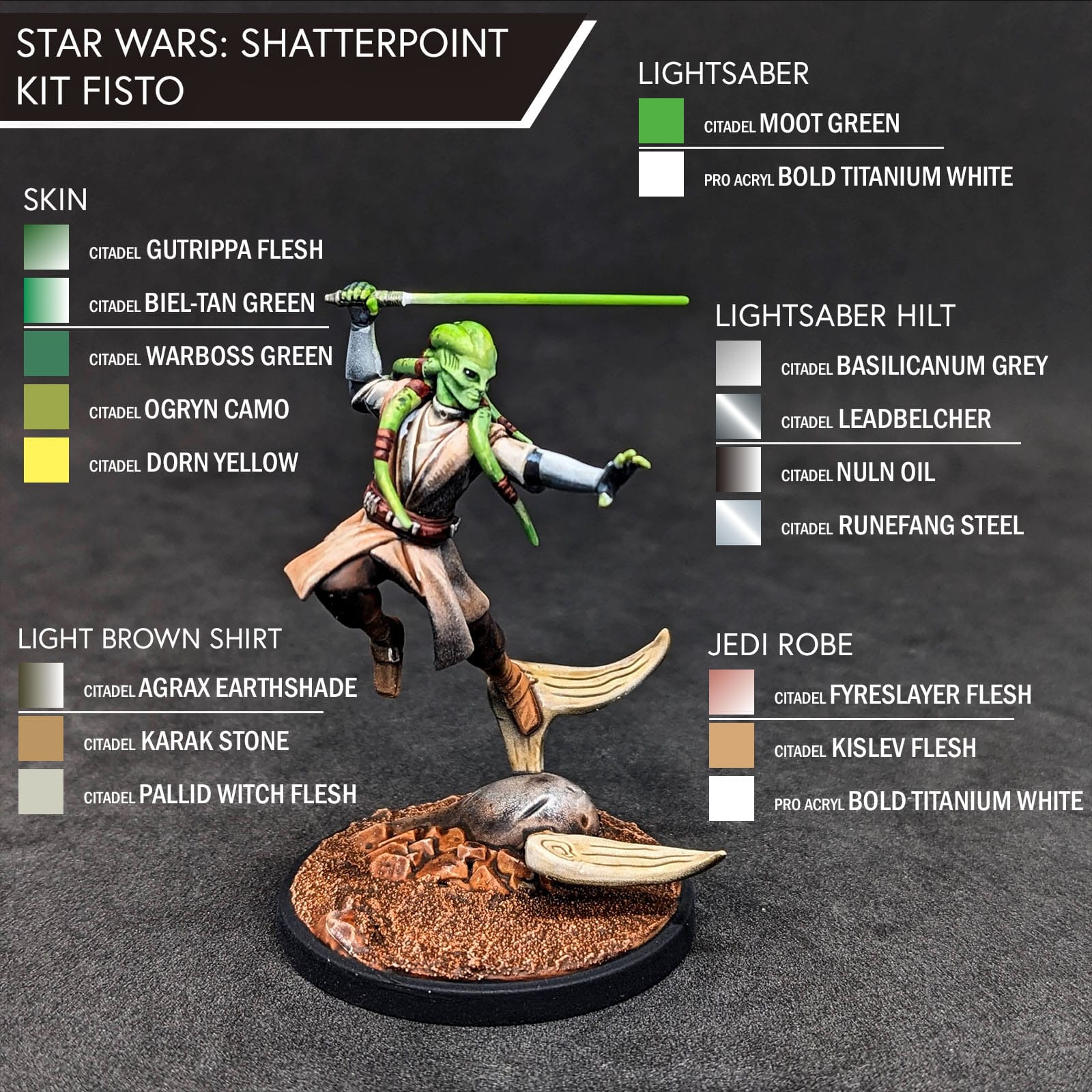
Jedi Master Kit Fisto
Kit has a really dynamic pose that pops out with the zenithal prime. Like all my pieces, I started with the lightest colors first, which tends to be white and/or the skin tone. Kit has green aquatic flesh, including some on his fingerless gloves. Also, I used the ‘Clone Armor Mix’ on his gauntlets. I moved onto the darker colors, doing the coloring blocking before moving into detailing. For the eyes, which are not noted on the picture, I simply made them black and added a small dot of white for reflection.
NOTE: For all metal bits, buckles, and clasps, I use a small spot of Runefang Steel.
Lightsaber Glow - The very last thing I did was do the lightsaber glow, as the colors underneath needed to be completed before applying Object Source Lighting (OSL), which I did with a dry brushing and some thinned down contrast. Unfortunately, since Kit is already green, the green glow really only showed up on his arm, cloth, and head tail bands.
Basing (Optional)
For his base, I started by lightly coating everything in Agrax Earthshade. I then went back over it and used Skeleton Horde on the Gor Helmet’s horns, Basilicanum Grey for the helmet itself, and Gore-Grunta fur for the sand. I dry-brushed Terminatus Stone over the sand and horns, and then I dry-brushed Necron Compound over the top of the Basilicanum to give it a slight metallic sheen to it.
Nahdar Vebb
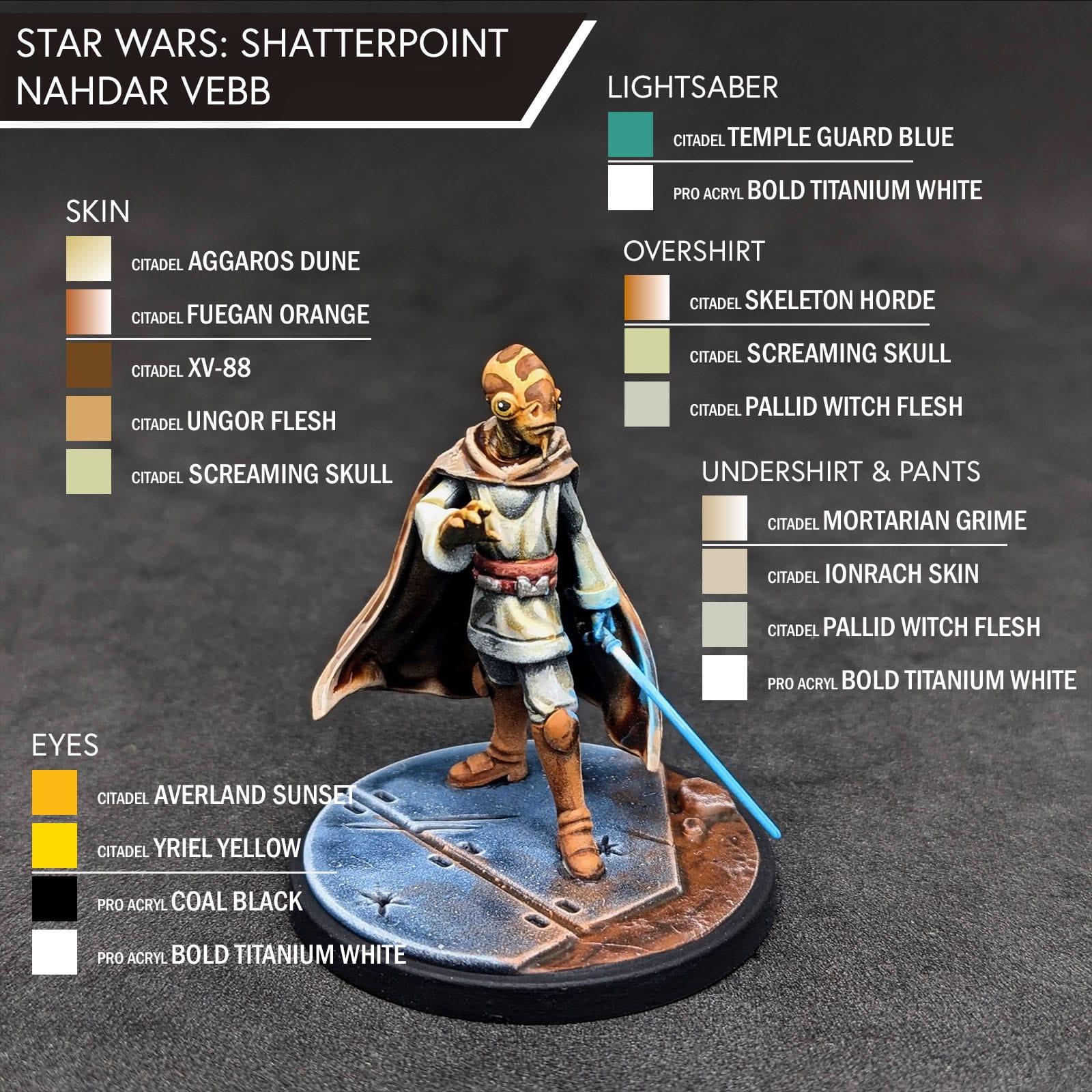
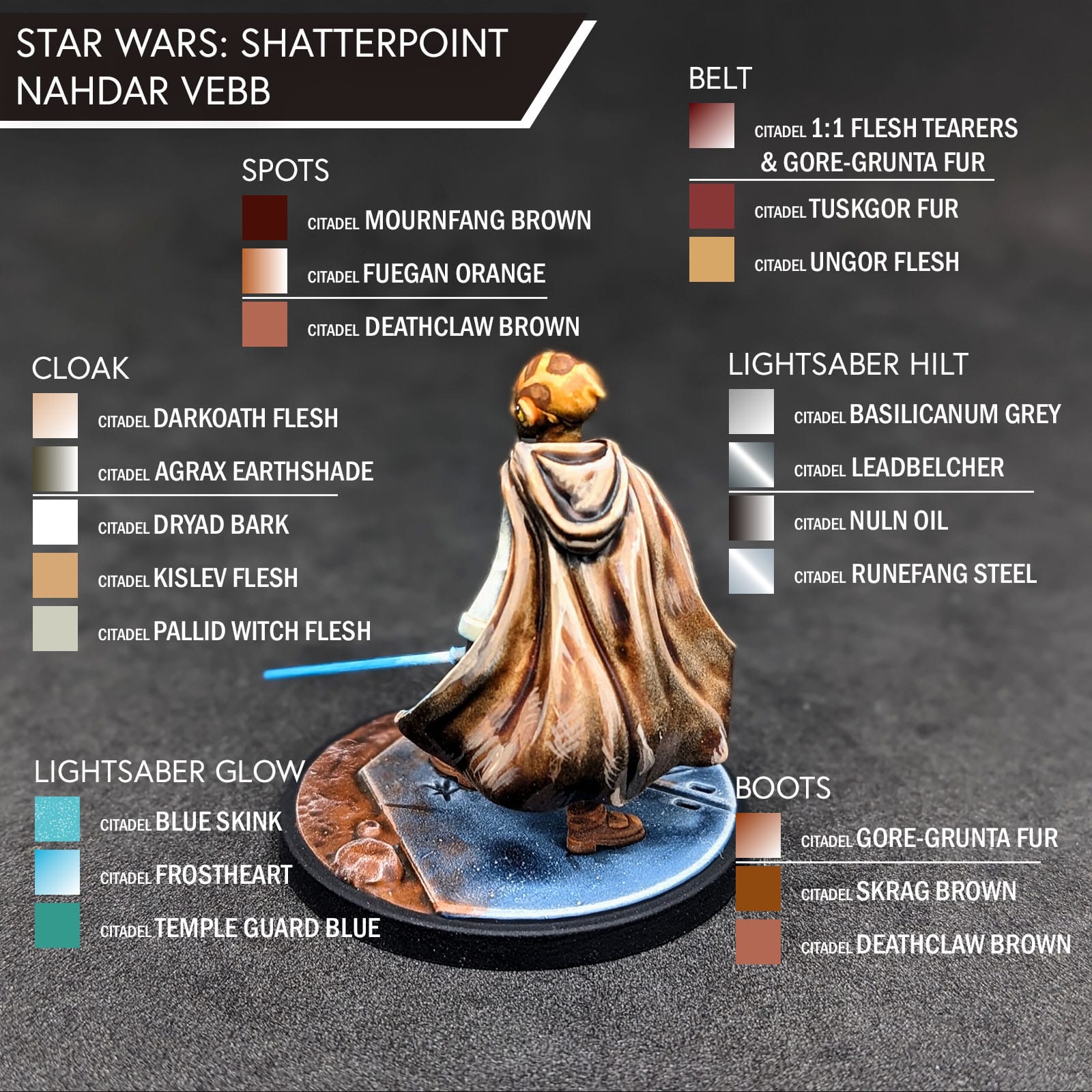
Nahdar Vebb, Jedi Knight
Like Kit, I started off with his flesh, but also his cloak since it was so light in color. The model itself doesn’t have any distinction for his brown patches, so I did my best to estimate their location and block them out with some Mournfang Brown. His cape took a little longer because I didn’t do a good job with the contrast and wash, so I had to go back in and fix some of my blending. I also added a little cross-hatching to give the illusion of the cloak being made of a stitched fabric.
Like with Kit, I saved the lightsaber OSL for last after I had finished all of the colors, ensuring to get the glow up underneath the cloak where the lightsaber glow would be showing.
Basing (Optional)
This base was primed with Army Painter Wolf Grey. I filled in the blast marks with Black Templar, let that dry, then did a coat of Drakenhoff Nightshade. After that dried, I dry-brushed Longbeard Grey over the blue areas. I blocked out the dirt with XV-88, then applied Gore-Grunt over the top. Once that dried, I did a dry-brush of Terminatus Stone and then lightly applied Fuegan Orange to the sand and brought it up over the metal, to give it an appearance of the sand having come over the top.
Clone Troopers - Commander Fil and Fil’s Clones
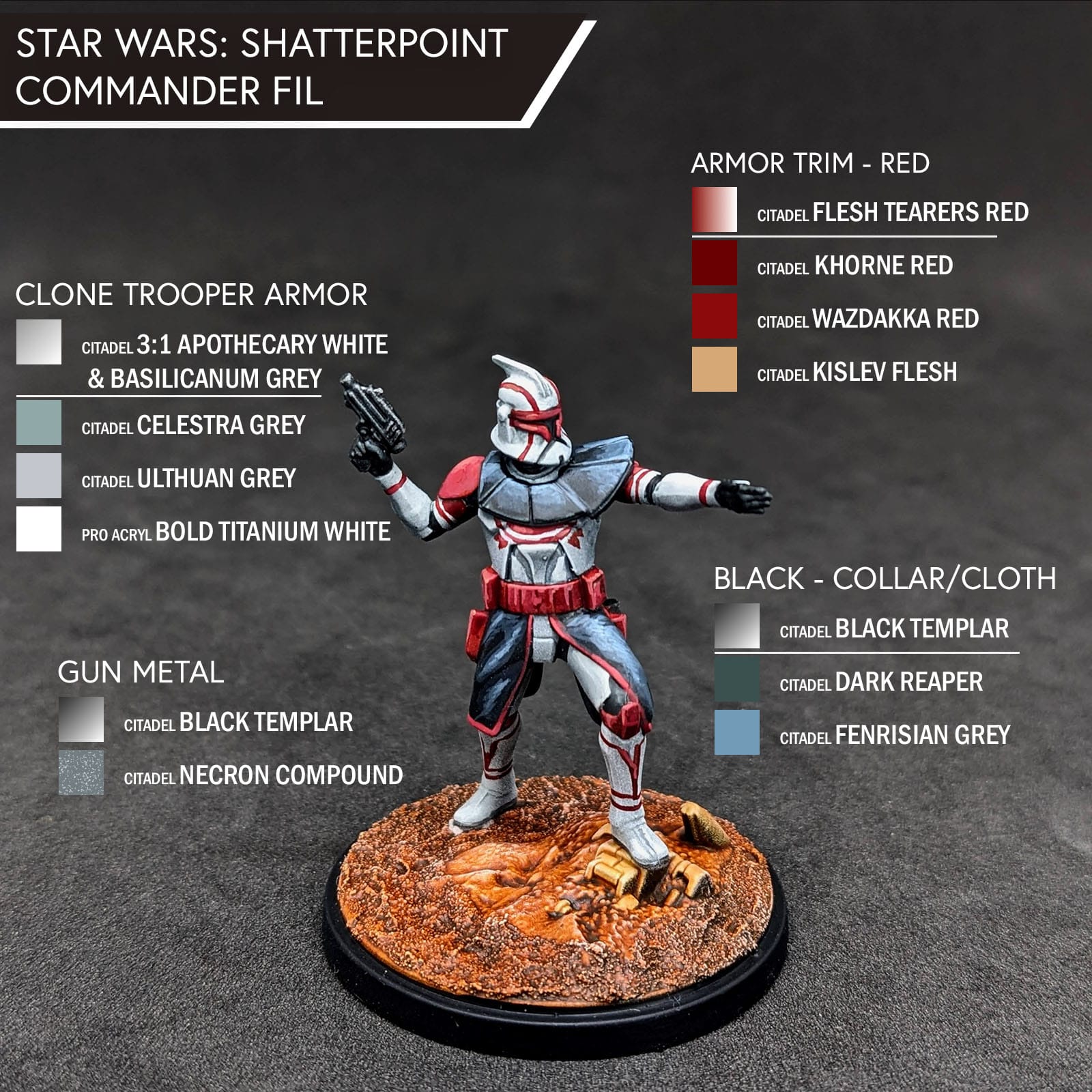

CC-3714 Clone Commander Fil
White Armor Painting
Painting white armor is one of the most difficult subjects to paint in miniatures and models!!!
Sorastro’s Painting has a fantastic painting guide video (below) for how to paint Clone Troopers, which you should check out now. I use this guide for all of my Clone Trooper and Stormtroopers for Star Wars: Legion and Star Wars: Shatterpoint. Not only is the guide incredibly easy to follow, but it has great music.
I always start with white, and made sure to touch up any missed spots. After that was done, I went back over the areas that would be black, including the under armor cloth, epaulette, and blasters. The red I applied after the white was done drying. Applying a base color layer of contrast over armor helps give it a little more dynamic to the tone, which meant applying highlights of red went very quickly.
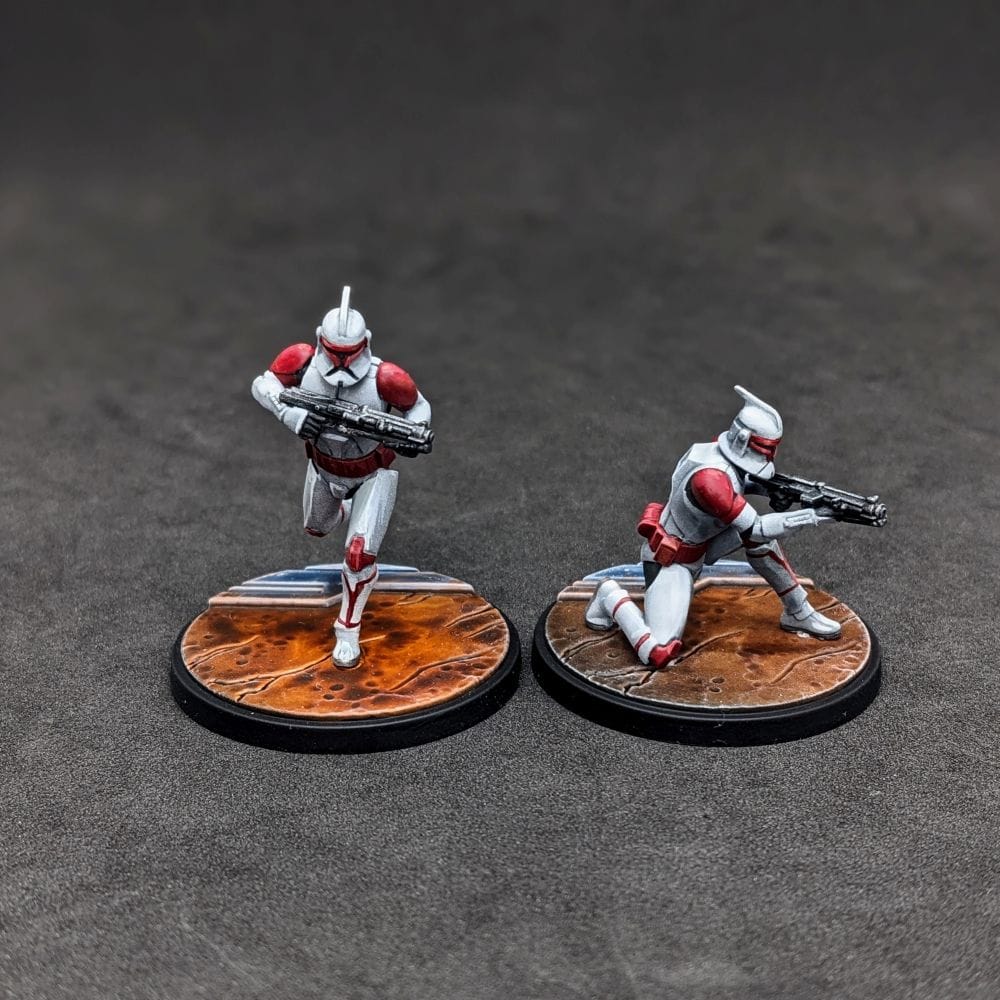

Fil's Clones
Basing (Optional)
Both of the clone bases (one of which I used from another set to make their unit cohesive), were primed white and black . I started with painting the metal in Russ Grey, and then followed the same steps I did with Nahdar, except I skipped applying Xv-88 and went straight to Gore-Grunta fur. Unevenly priming them white gives me a little more dynamic shading when I apply the contrast paints.
After all of my figures and bases are painted, I glue them together, apply a little touch up paint if needed, and then paint the base rims black.
SEALING
As I do with all of the models I paint that I also play, I apply a protective clear coating over the paint. This helps preserve the paint on the model and keeps oils from the hands from rubbing off the paint as you continuously touch the models during games. There are many different kinds of clear varnishes to use, but I typically use any matte or anti-shine varnishes, as satin, semi-gloss, and gloss tend to distort the colors of the models (not to mention that most models aren’t supposed to be shiny).
Brands that have been reliable for me are Krylon Matte Clear Spray, Rustoleum Matte Clear Coat, which is slightly glossy, and Testors Dullcote, although the latter can be expensive and difficult to find. For a coat with no shine that really enhances the colors, I use AK Interactive’s Ultra Matte Varnish, applied with an airbrush.
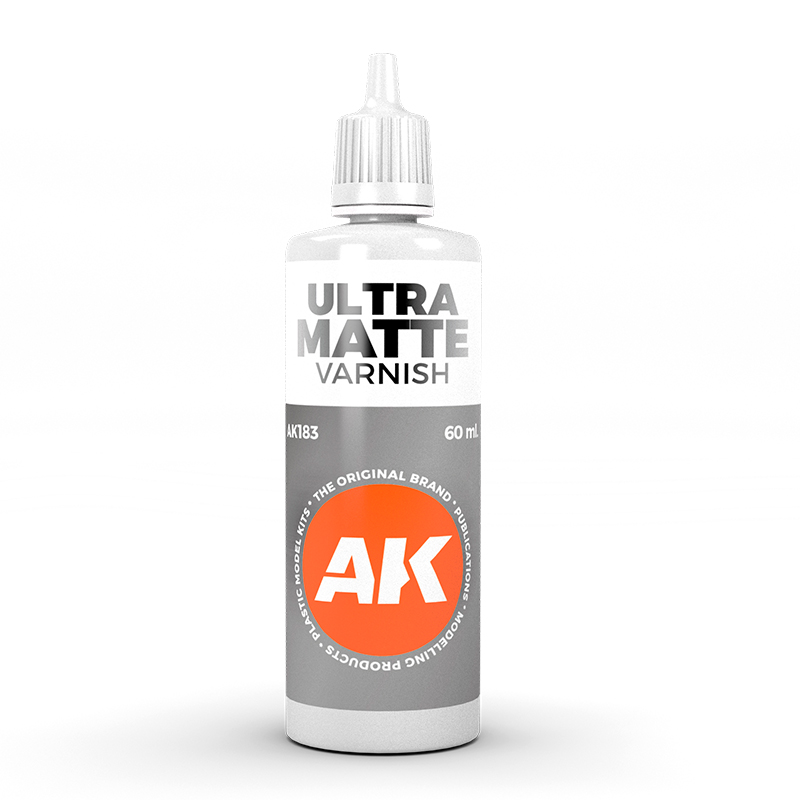
CONCLUSION
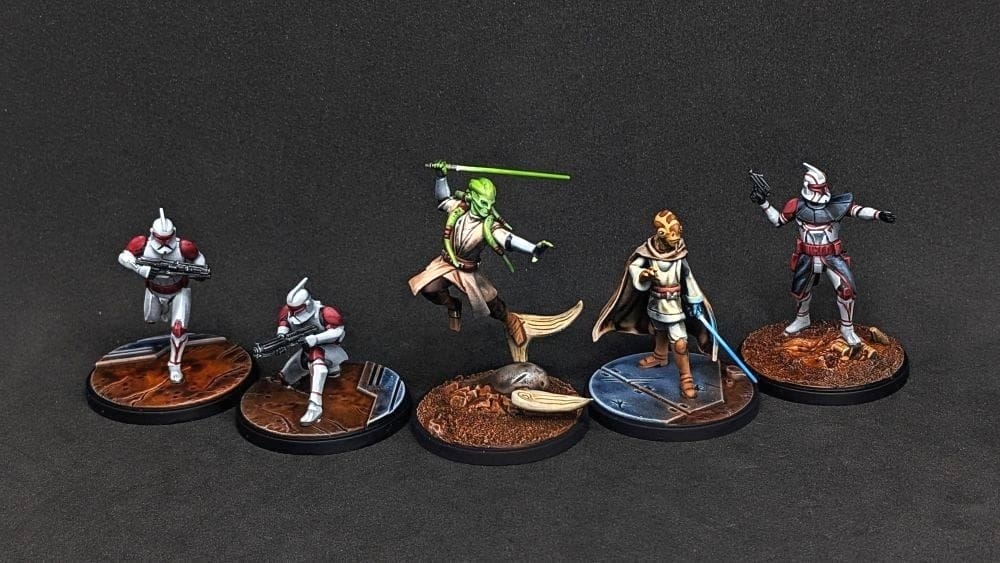
While this is a great box to paint, it’ll take a little effort to get them all painted. There are a lot of little details with many subtle color choices if we’re sticking to box/source colors. White armor is always difficult to paint, and it honestly takes a lot of practice to be able to do it quickly. Don’t be discouraged if it doesn’t look quite the way you want it, too. Each piece you paint is more experience gained at the painting. If you’re really unhappy with the armor painting, you can always apply little blast marks, scuff marks, or black lines to show some battle damage.
Take your time, and go slow. Let the paints dry before moving on to the next highlight. If you need to touch up areas before moving on, that’s totally ok. With these minis especially, I found myself cleaning up spots of browns on light tans a lot.
Lightsaber OSL is always fun for me, even if the green I usually use got lost on Kit’s skin. If I wanted to make it pop more I’d probably have added more white to the glow, but I think, overall, he stands out well. I am especially happy with how Nahdar’s head and eyes turned out. I hope he lasts longer on the table than he does in the show.
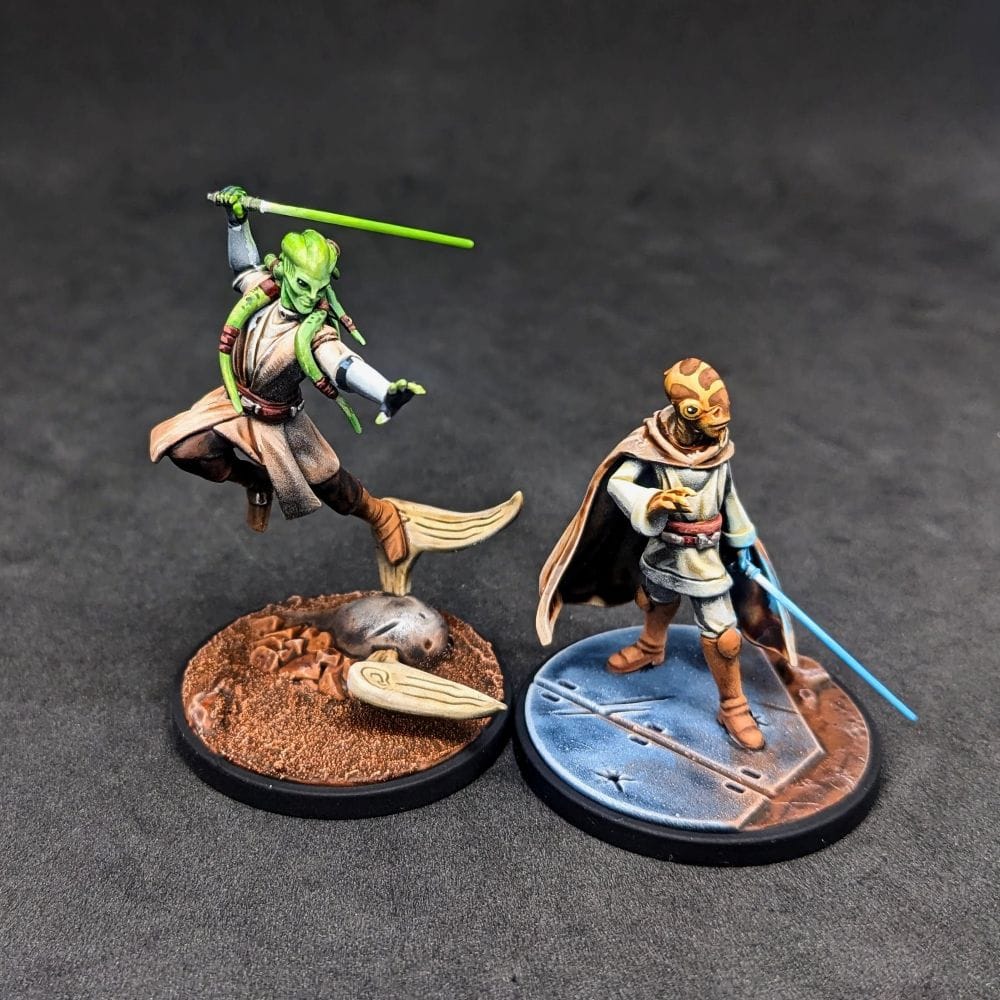

Quick Paint ONLY Total Paint Time (with priming) - 1-2 hours per figure
Quick Paint & Detailing Total Paint Time (with priming) - 2-3 hours per figure
Have you painted your ‘Requesting Your Surrender’ Squad Pack box yet? Let us know! Follow Gaming Trend for more Learn to Paint and Star Wars: Shatterpoint articles. We’d love to see how you painted up your models so share your work with us in the comments!












